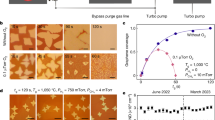Abstract
PYROLYTIC boron nitride is usually prepared by the thermal decomposition of boron trichloride and ammonia vapours on graphite substrates at 1,900° C. It has a density of 2.0–2.2 g/cm3 and a crystallite size of 50–100 Å and the hexagonal crystallites are aligned with their c-axes preferentially perpendicular to the substrate1,2. The preferred orientation of the boron nitride crystallites, ΔφFWHM(002), defined as the full width at half-maximum intensity of the 002 orientation distribution function, is 50°–100° (ref. 3). These properties are similar to those for pyrolytic graphite deposited at 1,900° C. Pure boron nitride sublimes in one atmosphere of nitrogen at temperatures of 2,330° C4 to 3,000° C2, compared with 3,700° C for graphite. Pyrolytic graphite, usually deposited at 2,100–2,200° C, can be converted into a material resembling single crystal graphite by annealing at temperatures to 3,600° C5, by tensile deformation parallel to the predominant direction of the basal planes of the crystallites at temperatures above 2,700° C6,7, or by compression annealing perpendicular to the basal planes at temperatures above 2,800° C8,9. Because pyrolytic boron nitride and pyrolytic graphite are similar in structure and in many properties, it was of interest to determine whether annealing or hot working could cause a significant structural transformation in the boron nitride.
This is a preview of subscription content, access via your institution
Access options
Subscribe to this journal
Receive 51 print issues and online access
$199.00 per year
only $3.90 per issue
Buy this article
- Purchase on Springer Link
- Instant access to full article PDF
Prices may be subject to local taxes which are calculated during checkout
Similar content being viewed by others
References
Basche, M., and Schiff, D., Mat. Design Eng., 78 (February 1964).
“Boralloy” Data Sheet, High Temperature Materials, Inc., Lowell, Massachusetts (February 1965).
Guentert, O. J., and Mozzi, R. L., Nature, 193, 570 (1962).
JANAF Table for Boron Nitride.
Klein, C. A., Straub, W. D., and Diefendorf, R. J., Phys. Rev., 125, 468 (1962).
Martens, H. E., and Kotlensky, W. V., Proc. Fifth Conf. on Carbon, 2, 625 (1963).
Stover, E. R., General Electric Co. Res. Rep. No. 61-RL-2745M (1961).
Moore, A. W., Ubbelohde, A. R., and Young, D. A., Nature, 198, 1192 (1963); Proc. Roy. Soc., A, 280, 153 (1964).
Gremion, R., and Maire, J., Rev. Hautes Temp. Refract., 1, 216 (1964).
Kotlensky, W. V., and Martens, H. E., Nature, 196, 1090 (1962).
Pease, R. S., Acta Cryst., 5, 356 (1952).
Kotlensky, W. V., and Martens, H. E., Tech. Rep. No. 32–299, Jet Propulsion Laboratory, California Institute of Technology (1963).
Author information
Authors and Affiliations
Rights and permissions
About this article
Cite this article
MOORE, A. Compression Annealing of Pyrolytic Boron Nitride. Nature 221, 1133–1134 (1969). https://doi.org/10.1038/2211133a0
Received:
Issue Date:
DOI: https://doi.org/10.1038/2211133a0
This article is cited by
Comments
By submitting a comment you agree to abide by our Terms and Community Guidelines. If you find something abusive or that does not comply with our terms or guidelines please flag it as inappropriate.



